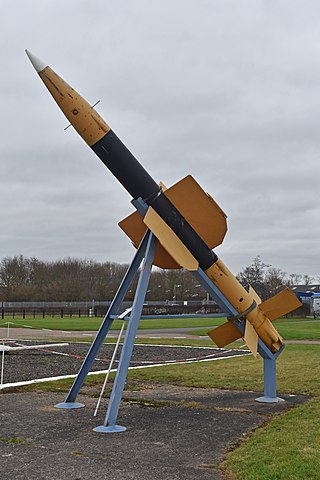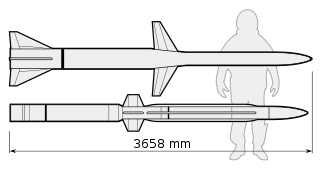Related Research Articles

The Avro Blue Steel was a British air-launched, rocket-propelled nuclear armed standoff missile, built to arm the V bomber force. It allowed the bomber to launch the missile against its target while still outside the range of surface-to-air missiles (SAMs). The missile proceeded to the target at speeds up to Mach 3, and would trigger within 100 m of the pre-defined target point.

In military terminology, a missile is a guided airborne ranged weapon capable of self-propelled flight usually by a jet engine or rocket motor. Missiles are thus also called guided missiles or guided rockets. Missiles have five system components: targeting, guidance system, flight system, engine and warhead. Missiles come in types adapted for different purposes: surface-to-surface and air-to-surface missiles, surface-to-air missiles, air-to-air missiles, and anti-satellite weapons.

A glide bomb or stand-off bomb is a standoff weapon with flight control surfaces to give it a flatter, gliding flight path than that of a conventional bomb without such surfaces. This allows it to be released at a distance from the target rather than right over it, allowing a successful attack without the aircraft needing to survive until reaching the target.

The Bristol Bloodhound is a British ramjet powered surface-to-air missile developed during the 1950s. It served as the UK's main air defence weapon into the 1990s and was in large-scale service with the Royal Air Force (RAF) and the forces of four other countries.
Green Cheese, a rainbow code name, was a British-made radar-guided anti-ship missile project of the 1950s. Green Cheese arose as part of the 'Sverdlov crisis', when the Royal Navy were concerned over the appearance of a new Soviet heavy cruiser class. It was a longer-ranged and guided replacement for the unguided Red Angel, which had required an approach by the attacker too close to be considered survivable.

Seaslug was a first-generation surface-to-air missile designed by Armstrong Whitworth for use by the Royal Navy. Tracing its history as far back as 1943's LOPGAP design, it came into operational service in 1961 and was still in use at the time of the Falklands War in 1982.

The Hughes AIM-47 Falcon, originally GAR-9, was a very long-range high-performance air-to-air missile that shared the basic design of the earlier AIM-4 Falcon. It was developed in 1958 along with the new Hughes AN/ASG-18 radar fire-control system intended to arm the Mach 3 XF-108 Rapier interceptor aircraft and, after that jet's cancellation, the YF-12A. It was never used operationally, but was a direct predecessor of the AIM-54 Phoenix used on the Grumman F-14 Tomcat.

The AGM-62 Walleye is a television-guided glide bomb which was produced by Martin Marietta and used by the United States Armed Forces from the 1960s-1990s. Most had a 250 lb (113 kg) high-explosive warhead; some had a nuclear warhead. The designation of the Walleye as an "air-to-ground missile" is a misnomer, as it is an unpowered bomb with guidance avionics, similar to the more modern GBU-15. The Walleye was superseded by the AGM-65 Maverick.

The Vickers Vigilant was a British 1960s era MCLOS wire-guided anti-tank missile used by the British Army. It was also licence-built in the United States by Clevite for the US Marine Corps, and sometimes known as Clevite rounds in this case.

The AIM-152 AAAM was a long-range air-to-air missile developed by the United States. The AIM-152 was intended to serve as the successor to the AIM-54 Phoenix. The program went through a protracted development stage but was never adopted by the United States Navy, due to the ending of the Cold War and the reduction in threat of its perceived primary target, Soviet supersonic bombers. Development was cancelled in 1992.

Popeye is a family of air-to-surface missiles developed and in use by Israel, of which several types have been developed for Israeli and export users. A long-range submarine-launched cruise missile variant of the Popeye Turbo has been speculated as being employed in Israel's submarine-based nuclear forces. The United States operated the Popeye under a different designation according to US naming conventions as the AGM-142 Have Nap.

The Kh-59 Ovod is a Russian TV-guided cruise missile with a two-stage solid-fuel propulsion system and 200 km range. The Kh-59M Ovod-M is a variant with a bigger warhead and turbojet engine. It is primarily a land-attack missile but the Kh-59MK variant targets ships.
UB.109T, better known as Red Rapier, was a British cruise missile project calling for a system able to deliver a 5,000 lb conventional warhead within 100 yards of its target at over 400 nautical miles range while travelling at 600 mph (970 km/h) at 50,000 ft (15,000 m).

Red Dean, a rainbow code name, was a large air-to-air missile developed for the Royal Air Force during the 1950s. Originally planned to use an active radar seeker to offer all-aspect performance and true fire-and-forget engagements, the valve-based electronics demanded a missile of prodigious size.

Operational Requirement F.155 was a specification issued by the British Ministry of Supply on 15 January 1955 for an interceptor aircraft to defend the United Kingdom from Soviet high-flying nuclear-armed supersonic bombers.

The GAM-63 RASCAL was a supersonic air-to-surface missile that was developed by the Bell Aircraft Company. The RASCAL was the United States Air Force's first nuclear armed standoff missile. The RASCAL was initially designated the ASM-A-2, then re-designated the B-63 in 1951 and finally re-designated the GAM-63 in 1955. The name RASCAL was the acronym for RAdar SCAnning Link, the missile's guidance system. The RASCAL project was cancelled in September 1958.

A precision-guided munition is a guided munition intended to precisely hit a specific target, to minimize collateral damage and increase lethality against intended targets. During the First Gulf War guided munitions accounted for only 9% of weapons fired, but accounted for 75% of all successful hits. Despite guided weapons generally being used on more difficult targets, they were still 35 times more likely to destroy their targets per weapon dropped.
Television guidance (TGM) is a type of missile guidance system using a television camera in the missile or glide bomb that sends its signal back to the launch platform. There, a weapons officer or bomb aimer watches the image on a television screen and sends corrections to the missile, typically over a radio control link. Television guidance is not a seeker because it is not automated, although semi-automated systems with autopilots to smooth out the motion are known. They should not be confused with contrast seekers, which also use a television camera but are true automated seeker systems.

The Pelican, also known as Bomb Mark 55 and, in one version, SWOD Mark 7, was a guided bomb developed by the United States Navy during World War II. Guided by semi-active radar homing, Pelican was produced in 1,000 lb (450 kg) and 1,500 lb (680 kg) sizes; the program reached the stage of live trials before being cancelled.
Red Hebe was a large active radar homing air-to-air missile developed by Vickers for the Royal Air Force's Operational Requirement F.155 interceptor aircraft. It was a development of the earlier Red Dean, which was not suitable for launch by the new supersonic aircraft. Before progressing much beyond advanced design studies, F.155 was cancelled in the aftermath of the 1957 Defence White Paper which moved Britain's attention from strategic bombers to ballistic missiles. With no other suitable platform, Red Hebe was cancelled as well.
References
Citations
- ↑ Roy Dommett. "The Blue Streak Weapon" (PDF). British Rocketry Oral History Programme. Archived from the original (PDF) on 18 February 2012. Retrieved 15 September 2012.
- 1 2 3 Forbat 2012, p. 46.
- 1 2 3 Flintham 2008, p. 272.
- ↑ Forbat 2012, p. 50.
- 1 2 Forbat 2012, p. 52.
- ↑ Forbat 2012, p. 61.
- ↑ Forbat 2012, p. 60.
- ↑ Morton 1989, p. 182.
- ↑ "Blue Boar air-to-surface TV-guided missile". Brooklands Museum.
Bibliography
- Forbat, John (2012). "3: Blue Boar Guided Gliding Bomb". The Secret World of Vickers Guided Weapons. History Press. pp. 45–64. ISBN 9780752487922.
- Flintham, Vic (2008). High Stakes: Britain's Air Arms in Action, 1945–1990. Pen and Sword. ISBN 9781473814936.
- Morton, Peter (1989). Fire Across the Desert: Woomera and the Anglo-Australian Joint Project, 1946-1980. Australian Government Publishing Service. ISBN 9780644060684.
